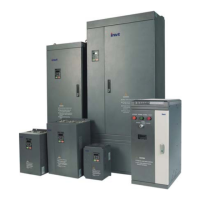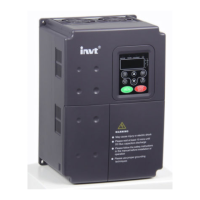Wiring
30
based on EMC features of inverter, introduces EMC installation process in several
aspects of application (noise control, site wiring, grounding, leakage current and power
supply filter). The good effective of EMC will depend on the good effective of all of these
five aspects.
4.7.3.1 Noise control
All the connections to the control terminals must use shielded wire. And the shield layer of
the wire must ground near the wire entrance of inverter. The ground mode is 360 degree
annular connection formed by cable clips. It is strictly prohibitive to connect the twisted
shielding layer to the ground of inverter, which greatly decreases or loses the shielding
effect.
Connect inverter and motor with the shielded wire or the separated cable tray. One side
of shield layer of shielded wire or metal cover of separated cable tray should connect to
ground, and the other side should connect to the motor cover. Installing an EMC filter can
reduce the electromagnetic noise greatly.
4.7.3.2 Site wiring
Power supply wiring: the power should be separated supplied from electrical transformer.
Normally it is 5 core wires, three of which are fire wires, one of which is the neutral wire,
and one of which is the ground wire. It is strictly prohibitive to use the same line to be both
the neutral wire and the ground wire
Device categorization: there are different electric devices contained in one control cabinet,
such as inverter, filter, PLC and instrument etc, which have different ability of emitting and
withstanding electromagnetic noise. Therefore, it needs to categorize these devices into
strong noise device and noise sensitive device. The same kinds of device should be
placed in the same area, and the distance between devices of different category should
be more than 20cm.
Wire Arrangement inside the control cabinet: there are signal wire (light current) and
power cable (strong current) in one cabinet. For the inverter, the power cables are
categorized into input cable and output cable. Signal wires can be easily disturbed by
power cables to make the equipment malfunction. Therefore when wiring, signal cables
and power cables should be arranged in different area. It is strictly prohibitive to arrange
them in parallel or interlacement at a close distance (less than 20cm) or tie them together.
If the signal wires have to cross the power cables, they should be arranged in 90 angles.
Power input and output cables should not either be arranged in interlacement or tied
